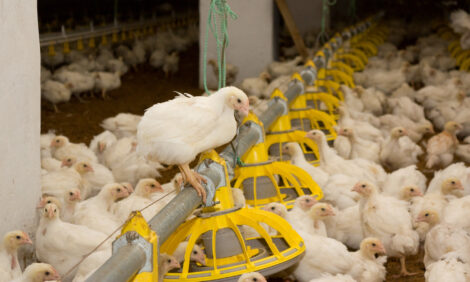



Effect of Phytase Supplementation to Diets Varying in Chloride Level on Performance, Litter Moisture, Foot Pad Score and Gait Score of Growing Turkeys
For turkey diets containing high levels of alternative by-products, such as distillers dried grains and canola meal, it is important to consider chloride, phytase and associated dietary electrolyte balance, according to researchers based in Egypt and the US.Phytase has been examined by M.H. Farahat of Zagazig University in Egypt and co-workers there and at the University of Minnesota as a means to improve turkey performance in diets with a high chloride content by modifying dietary electrolyte balance.
Their paper in Poultry Science explains that Nicholas turkey toms (10 poults per pen; 10 replicates per pen) were fed diets based on corn, soy, distillers dried grains with solubles (DDGS) and canola meal (DDGS/CM) with varying chloride levels (0.2, 0.3, 0.4 or 0.5 per cent) and phytase (0 or 500 phytase units per kg of diet), making eight treatments (4×2 factorial). A ninth treatment was a corn-soy based diet (CS) with 0.3 per cent chloride and without phytase (positive control).
The diets were formulated to contain similar nitrogen-corrected apparent metabolisable energy and digestible amino acid levels for each of five feeding periods (2 to 5, 5 to 8, 8 to 11, 11 to 14 and 14 to 17 weeks of age) and fed in mash form.
Turkey bodyweight, average daily gain, average daily feed intake and feed conversion ratio (FCR) were determined for each pen along with litter moisture, foot pad and gait scores.
An ANOVA was conducted to determine the effects of chloride, phytase and their interaction.
Turkey bodyweight, average daily gain and average daily feed intake decreased in a linear or curvilinear manner with increasing diet chloride (P<0.05).
At 17 weeks of age, litter moisture and foot pad score showed a cubic trend with diet chloride (P<0.05).
Phytase improved FCR during 8 to 11 weeks and increased litter moisture at 11 weeks of age (P<0.003).
Phytase modified the FCR response to chloride during 2 to 5 and 14 to 17 weeks of age at the two lowest levels of dietary chloride (P<0.05).
Turkeys fed CS had better bodyweight and FCR to 17 weeks of age than those receiving DDGS/CM at 0.3 per cent chloride.
Based on bodyweight, minimum dietary electrolyte balance based on sodium, potassium and chloride was found to be 247, 217, 200, and 171 mEq/kg during 5 to 8, 8 to 11, 11 to 14, and 14 to 17 weeks of age, respectively.
Farahat and co-authors say their findings emphasise the importance of considering chloride, phytase and associated dietary electrolyte balance in turkey diets containing high levels of alternative byproducts.
Reference
Farahat M.H., W.M. Abdel-Razik, E.I. Hassanein and S.L. Noll. 2013. Effect of phytase supplementation to diets varying in chloride level on performance, litter moisture, foot pad score, and gait score of growing turkeys. Poult. Sci. 92(7):1837-1847. doi: 10.3382/ps.2012-02869
August 2013









